|
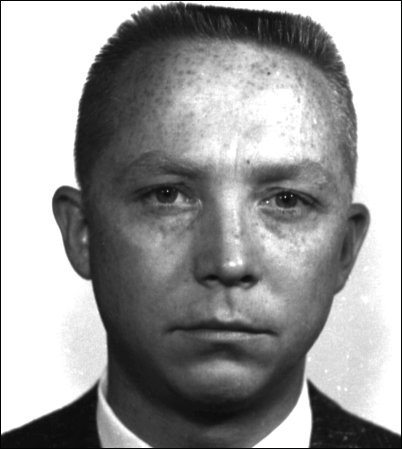
Fireman Donald J. Romps
|
|
I N M E M O R I A M
An 8-year veteran of the Los Angeles City
Fire Department, Fireman Donald J. Romps, lost his life fighting
a greater alarm fire at 857 South San Pedro. Funeral
Services were held on Wednesday, September 16, 1970, at 1030
hours at St. Bernardine Church, 22410 Calvert St. in Woodland
Hills. Interment followed at San Fernando Mission
Cemetery. Fireman Romps was born on January 12, 1940 in
Chicago, Illinois. He was appointed to the Fire Department on
May 12, 1962 and had worked at Mt. Patrol 1, Engine 97, Engine
88, Westlake (dispatch), Coldwater (dispatch), Truck 94, Squad
22, Engine 30 and Truck 30.
In addition to Fireman Romps, three other firemen
suffered injures. Nine City fire units under Division
Commander Joseph Winn battled the stubborn fire for 22
minutes. The major portion of the blaze was confined to
the second floor of a three story commercial building. The
entire structure was filled with dense smoke. The loss to
the building and contents has been estimated at over
$300,000. The building was used for the manufacturing of
clothing apparel. Arson units are investigating the cause.
|
|
|
99
Friday, September 11, 1970
1934 hrs, Audio alarm, box 9th and San Julian, corrected to 9th
and San Pedro. Used 5 sections of 2-1/2", 800'
1-1/2", 150' of 1", laid from San Pedro off of Pump
9. Entered the building from the second floor balcony of
fire escape. Took 2 1-1/2" lines in. Truck Co.
checked 3rd floor for extension. Used 1" and
1-1/2" line to cover personnel trapped and out of
air. Fireman Rainey (T-30C) and Fireman Romps
(T-30B) air bottles expended, removed by aerial and taken
to Central Rec. Frm. Rainey satisfactory condition, Frm
Romps deceased at this writing.
Fire Station 30 Journal
entry.
|
|
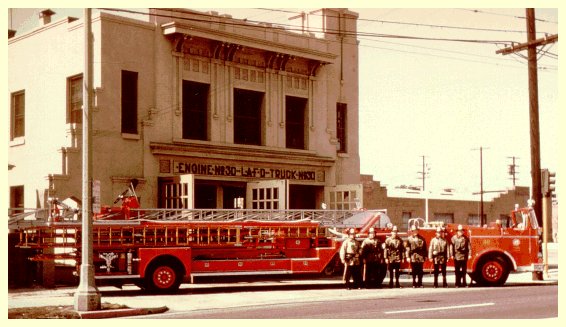
Truck Company No. 30
Fireman Reams Rainy, Fireman Ed Burnham, Fireman Walt Spomer,
Fireman Harley Harper,
Engineer Jim Birken and Captain Bob Foster.
1962
Source: Battalion Chief Larry Schneider |
|

RAYMOND M. HILL
CHIEF ENGINEER AND GENERAL MANAGER
November 10, 1970
TO: Bureau Commander,
Bureau of Fire Suppression and Rescue
FROM: Ass't. Chief T. T. Whippo, Battalion Chief
W. B. Nash, and Battalion
Chief A. E. Jordan
SUBJECT: BOARD OF HONORARY AWARDS
In pursuit of our assignment "to investigate the actions
and conduct of Fireman Reams W. Rainey, Truck Company 30
"C" Platoon, who was involved in an attempted rescue
of Fireman Donald J. Romps on September 11, 1970, "the
above named Committee has convened twice to interview Fireman
Rainey as well as others to secure the essential information
necessary to reach a judgment and make recommendations.
On November 5, 1970 at Fire Station No. 22, we interviewed
Fireman Rainey and Captain Robert N. Foster, Engine 22,
"C" Platoon. The latter officer was in charge of
the activities of Truck Company 30, at the greater alarm fire,
1934 hours, 857 San Pedro Street.
On November 6, 1970 at Fire Station No. 30, we interviewed Engineer
Pat O. Tierney, Engine Company 30, "B" Platoon and
Fireman Lee R. Hook and F. Wayne Humbard both of Truck Company
30, "B" Platoon.
The Committee, accompanied by Engineer Tierney, also visited the
fire damaged premises at 857 South San Pedro Street on November
6, 1970.
Step by step our questioning and inspecting developed a dramatic
pattern of actions taken by Firemen under conditions of extreme personal
risk or actions of such character as to require much initiative
and ability.
To understand and appreciate the situation as it existed on the
second floor of the involved structure, it must be realized that
the floor of the involved structure was charged with the thick,
black smoke common to burning plastic materials. The
concrete-steel building was tightly sealed. Windows were
of steel sash and frame with an openable portion that operated
by swinging out from the bottom on a top hinge. These windows
were painted to prevent entry of any light and were
bolted shut. There was no visibility and every
cubic inch o f space was filled with black, oxygen deficient,
carbon monoxide laden smoke.
Several members of Task Force 30 equipped with breathing
apparatus, entered this floor from the fire escape
balcony. Ground ladders placed by the Truckmen provided
access to the balcony from the street. Two lines of 1
1/2" hose were advanced on to the floor. Flashlights were
utterly incapable of smoke penetration, so the lines were
advanced by feeling the way. Entrance from the balcony was
to a small room and the walls has to be felt over before doors
were found. One led into another small office and from
both rooms doors led into the large manufacturing area common to
the garment industry. Long parallel work tables with
intervening aisles comprised the situation here.
Progress was slow, and only by sound and feel were the various
members aware of each other. No great amount of heat was encountered
at first, so no water was used. Air supplies were running
low and some of the men were switching to reserve supplies and turning
back to the balcony and fresh air.
|
|
Bureau
Commander
-2-
November 10, 1970
Fireman Rainey, exploring ahead of his hose line had felt his
way down an aisle between work benches. His experienced touch
told him it was a garment industry work table and he felt out
its length which took him some fifty feet toward the seat of the
fire which was beyond another partition and was then being
actively engaged by Engine Company 9. Rainey felt a blast
of heat. This probably occurred when 9's put hose streams
on the fire and drove the heat toward an open door in the
partition and thence through toward Rainey
Behind Rainey, moving up with the 1 1/2"
hose line was Fireman Donald J. Romps and Engineer
Tierney. Romps preceded Tierney and was on the
nozzle. At about that time, Romps and Tierney became low
on air and in the muffled voices that come through breathing
apparatus face pieces, so informed each other. Romps did
not sound as if in trouble and Tierney said, "let's go
out" and started out following the hose line. When he
turned at the corner made by the end of the work table, he came
to confusing coils of hose and so dropped to his hands and
crawled on out. Tierney thought that Romps was right behind
him.
Captain Foster was nearby and he too was running low on
air. Some of the breathing apparatus in use was of the
type that rings a bell when the air supply reaches reserve
status. Captain Foster could hear these and knew that
likely the air supplies of the men with him were all being
depleted. Captain Foster made his was toward the balcony.
Fireman Rainey after experiencing the heat blast described
before, methodically turned and retraced his path down the work
table toward the balcony. After an appropriate distance he
felt for the corner and left turn he knew he must make.
This was about where the above described coils of hose
lay. At about this time he was hit from behind by a
lunging Fireman (Romps) and driven forward. Rainey
realized at once that the man had no breathing apparatus face
piece on (he had probably removed it in panic) and so, with remarkable
control, Rainey flipped his by-pass air switch on, removed his
own face piece and alternately began placing it on Romps face
and then on his own. All of this as he staggered forward
forced by the collapsing man at his side. They moved thus
for about fifteen feet to the front wall of the building.
(This was the same wall that the exterior fire escape balcony
was mounted on and about twenty-five to thirty feet south).
When Rainey removed his face piece, it, of course, was filled by
the smoke and so Rainey too began to get insufficient oxygen and
heavy doses of carbon monoxide as he would replace it on his
face. As they both collapsed at the wall, Rainey, almost unconscious
himself, dimly saw light through a window glass and, in a last
effort, broke the glass with his flashlight and called out the
opening, "Fireman down". He then passed out
completely.
Outside his cry was heard by Captain Foster and Engineer Tierney
who had just emerged from the building and by other members of
Task Force 30, on the ground.
Captain Foster and Engineer Tierney secured fresh air bottles,
estimated where they would have to get to and went immediately back
into the building. One, then two ground ladders were thrown
up to the broken windows. Quickly Fireman Lee R. Hook was
at the top of one and Fireman F. Wayne Humbard at the
other. Everyone at this moment thought that they were
concerned with only one fallen Fireman.
Hook, a large, physically strong man, reached through the two
broken window panes (about 12" x 15") and with one arm
lifted Rainey and with the other placed his breathing apparatus face piece
on the man's face. Fresh air was forced over Rainey's face
through the by-pass valve. Humbard reached in to help and
both men on the ladder were subjected to terrific punishment as
smoke poured out the broken window and over their faces.
An Elder resuscitator was brought to position and its face piece
sent up and substituted for that of the breathing apparatus.
This resuscitation, so begun, never ceased until Rainey revived
much later in the hospital.
|
|
Bureau
Commander
-3-
November 10, 1970
Hook and Humbard realized they must bring Rainey out the window
so others raised the aerial ladder to the adjoining
window. Precious time was expended while Hooks pecked
futilely at the steel window pane dividers with bolt cutters and
hack saw. During this, Humbard supported Rainey and held
the face piece on his face.
In much less time than the telling it takes, a disc power saw
was sent up the aerial ladder and the adjoining window quickly
and adequately cut.
Inside, Foster and Tierney after torturously negotiating the two
small rooms, (neither had been in the one in the south during
their previous entry) felt their way to Rainey. The disc
saw was just completing its cut and it left a sharp upward thrusting
piece of steel in the bottom of the opening. Disregarding
this sharp impediment, Foster and Tierney quickly and tenderly lifted
Rainey (Elder face piece always in position) to eager hands on
the aerial ladder. The sharp steel snagged at Rainey's turnout
coat almost as if the building was loath to give up its
victim. Shortly thereafter, Rainey's apparently lifeless
body was being transported to he hospital.
As Foster and Tierney settled back to rest before starting out,
Foster's hand encountered a Fireman's boot and in this manner,
it was learned that a second Fireman was down. This was
Donald Romps and once again the program of ceaseless
resuscitation was begun.
Determined that the sharp spike should not snatch at a victim
this time, Tierney called for a sledge hammer which was quickly
sent up the ladder and using it, he quickly flattened the
steel. The careful removal pattern was repeated and Romp's
body was sent futilely on its way to a hoped for miracle.
The outcome of this entire action is known to us all now.
What may not be so generally known however, are the details of
the heroic action described above. This Board was
tremendously impressed and affected, and we agree that
recognition should be bestowed where indicated. Accordingly,
we recommend as follows: That the department's Medal of Valor be
awarded to Fireman Reams W. Rainey. He, under conditions
of extreme personal risk and when he on his own was in no
jeopardy at all, shared his air supply with a falling comrade in
a valiant attempt to save his life. Given a little more
time, his great efforts might have succeeded. As it was,
he almost gave up his own life in his selfless effort.
That Captain Robert N. Foster, Engineer Pat O. Tierney and Fireman
Lee R. Hook and F. Wayne Humbard be each issued a Letter of
Special Commendation. We believe that their actions
described above were unusual and required much initiative and
ability. They are worthy of special recognition in the finest
sense and tradition of the Fire Service.
_________________________
T. T.
Whippo
Division III Commander
"C" Platoon
_________________________
W. B. Nash
Battalion 4 Commander
"C" Platoon
_________________________
A. E. Jordan
Battalion 5 Commander
"C" Platoon
TTW:mb
|
|
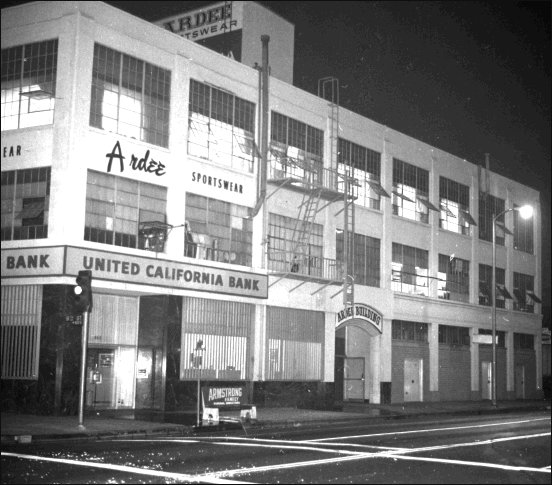
The Ardee Sportswear Building
San Pedro and Ninth Street
Photo taken before sunrise, early Saturday morning.
Source: LAFD Photo |
|
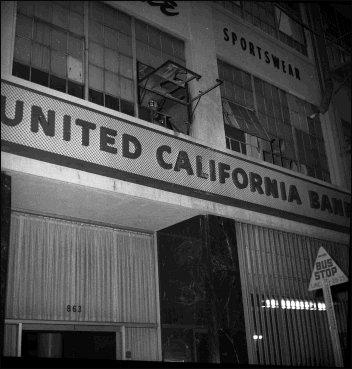
The window opening over the
"C" in California was where Rainey and Romps were located.
Source: LAFD Photo |
|
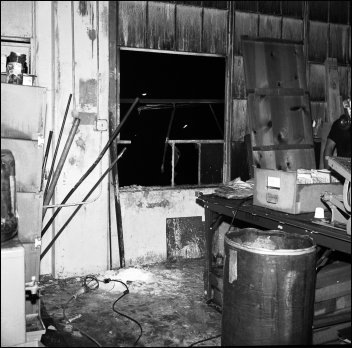
Inside view of room where
Rainey and Romps were found.
Source: LAFD Photo |
|